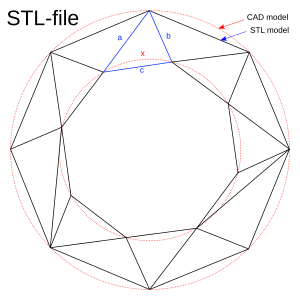STL (file format)

Example of STL vs CAD format
|
|
| Filename extension | .stl |
|---|---|
| Developed by | 3D Systems |
| Type of format | Stereolithography |
STL (STereoLithography) is a file format native to the stereolithography CAD software created by 3D Systems. STL has several after-the-fact backronyms such as "Standard Triangle Language" and "Standard Tessellation Language". This file format is supported by many other software packages; it is widely used for rapid prototyping, 3D printing and computer-aided manufacturing. STL files describe only the surface geometry of a three-dimensional object without any representation of color, texture or other common CAD model attributes. The STL format specifies both ASCII and binary representations. Binary files are more common, since they are more compact.
An STL file describes a raw unstructured triangulated surface by the unit normal and vertices (ordered by the right-hand rule) of the triangles using a three-dimensional Cartesian coordinate system. STL coordinates must be positive numbers, there is no scale information, and the units are arbitrary.
An ASCII STL file begins with the line
where name is an optional string (though if name is omitted there must still be a space after solid). The file continues with any number of triangles, each represented as follows:
where each n or v is a floating-point number in sign-mantissa-"e"-sign-exponent format, e.g., "2.648000e-002" (noting that each v must be non-negative). The file concludes with
The structure of the format suggests that other possibilities exist (e.g., facets with more than one "loop", or loops with more than three vertices). In practice, however, all facets are simple triangles.
...
Wikipedia
